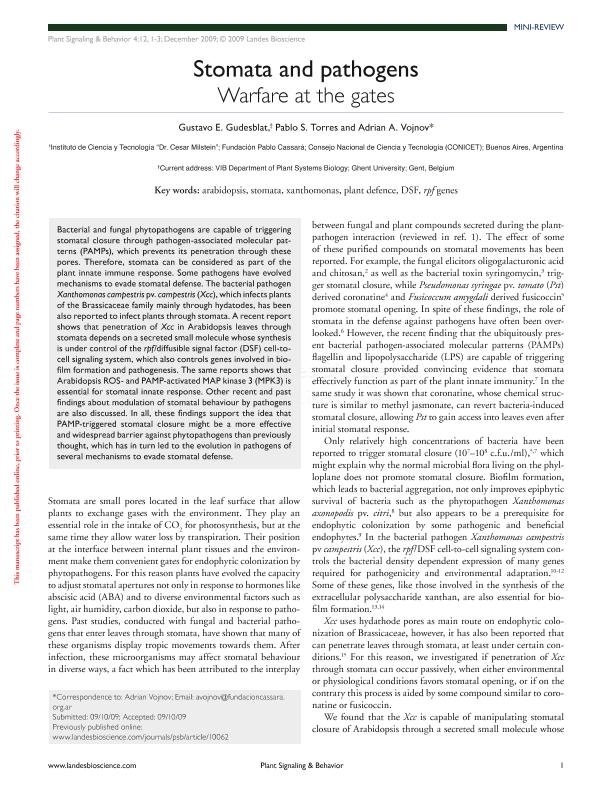Artículo
Stomata and pathogens: warfare at the gates
Fecha de publicación:
12/2009
Editorial:
Landes Biosciences
Revista:
Plant Signaling and behavior
ISSN:
1559-2316
Idioma:
Inglés
Tipo de recurso:
Artículo publicado
Clasificación temática:
Resumen
Bacterial and fungal phytopathogens are capable of triggering stomatal closure through pathogen-associated molecular patterns (PAMPs), which prevents its penetration through these pores. Therefore, stomata can be considered as part of the plant innate immune response. Some pathogens have evolved mechanisms to evade stomatal defense. The bacterial pathogen Xanthomonas campestris pv. campestris (Xcc), which infects plants of the Brassicaceae family mainly through hydatodes, has been also reported to infect plants through stomata. A recent report shows that penetration of Xcc in Arabidopsis leaves through stomata depends on a secreted small molecule whose synthesis is under control of the rpf/diffusible signal factor (DSF) cell-tocell signaling system, which also controls genes involved in biofilm formation and pathogenesis. The same reports shows that Arabidopsis ROS- and PAMP-activated MAP kinase 3 (MPK3) is essential for stomatal innate response. Other recent and past findings about modulation of stomatal behaviour by pathogens are also discussed. In all, these findings support the idea that PAMP-triggered stomatal closure might be a more effective and widespread barrier against phytopathogens than previously thought, which has in turn led to the evolution in pathogens of several mechanisms to evade stomatal defense.
Palabras clave:
ARABIDOPSIS
,
STOMATA
,
XANTHOMONAS
,
PLANT DEFENCE
Archivos asociados
Licencia
Identificadores
Colecciones
Articulos(ICT - MILSTEIN)
Articulos de INST.DE CS. Y TECNOLOGIA "DR. CESAR MILSTEIN"
Articulos de INST.DE CS. Y TECNOLOGIA "DR. CESAR MILSTEIN"
Citación
Gudesblat, Gustavo Eduardo; Torres, Pablo Sebastian; Vojnov, Adrián Alberto; Stomata and pathogens: warfare at the gates; Landes Biosciences; Plant Signaling and behavior; 4; 12; 12-2009; 1114-1116
Compartir
Altmétricas




